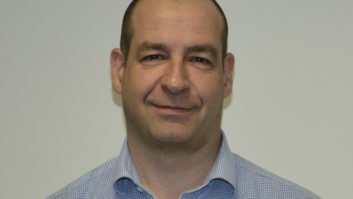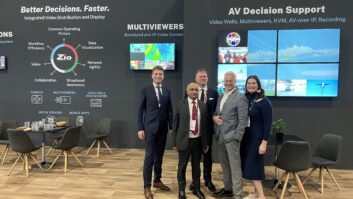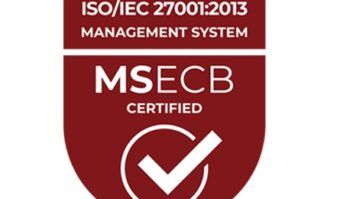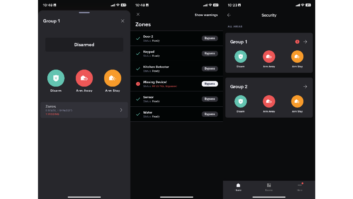Just as the G20 summit in London was about to begin last month, security plans were thrown into chaos when the UK’s Department for Transport told Westminster Council – the body responsible for the security of central London – that it must turn off its entire network of traffic CCTV cameras.
The reason? The Department had discovered that the cameras featured a resolution of only 704 x 576 – but a law that came into force on 1 April required them to have a minimum resolution of 720 x 576.
Staying abreast of ever-changing legislation is only one of many challenges facing the security industry. Uppermost in many minds, however, is the economic downturn.
“The economic climate has increased crime, including theft, and damage to property,” says Dominic Bruning, marketing director EMEA, Axis Communications. “The downturn increases the need for security, and drives companies to become more protective of their investments. However, we have also observed a certain slowdown in big infrastructure projects.”
“Nevertheless,” he continues, “the interest in network video solutions is growing. Their advantages include the ability to remotely monitor numerous locations from the desktop, enabling companies to cut travelling costs.”
The situation varies throughout Europe. “There is no one state of the European safety/security market,” points out Gerard Otterspeer, product marketing manager EMEA at Bosch Security Systems. “We really see a mixture of effects around Europe.”
“There are significant variations in different regions,” agrees Jukka Riivari, CEO of Mirasys, which is headquartered in Helsinki and develops software that manages the information captured by digital video and CCTV cameras. “While early adopters of CCTV, such as the UK, Finland and Spain, are considering the move from analogue to IP systems, other European countries are building highly advanced fibre optic networks with high-resolution cameras and centralised recording. In areas where legislation has traditionally made it difficult to deploy CCTV, such as Germany, France and Sweden, authorities are relaxing their regulations.”
“High-street retailers have deferred shop upgrades and many shops have closed,” notes Tony Makosinski, head of marketing for the UK and Ireland at Honeywell Security & Communications. “Industrial sites seem to have been less affected but new industrial estate development has virtually ceased, meaning fewer new systems are being installed.”
Uncertain outlook
The overall feeling seems to be one of uncertainty. In theory, the need for security and safety systems has never been greater – but at the same time, budgets have never been tighter. It will be interesting to see how it plays out.
A challenge beyond that presented by the economy, is the transition from analogue-based to digital-based systems – and here, the expected outcome is significantly clearer. Today, according to IMS Research, some 70% of the CCTV camera market is analogue – but a trend is apparent. “Last year, Sony IP camera sales into the security market grew by 31%,” notes Simon Nash, senior European marketing manager for video security at Sony Professional, “while analogue camera sales grew by just 4%.
“We have also recognised that many customers are looking to move from analogue to IP without having to replace their existing security infrastructure, and we now offer a range of solutions that allows them to do that. Such a hybrid approach alleviates the technical issues and the costs associated with switching to a new system.”
“The ability to support HD formats has been critical to the success of IP technology,” he continues. “That’s why our new hybrid recorder supports a dual HDMI interface – and we’ll be launching new IP cameras in 2009 that will support HD-streaming capability.”
Hetec’s Quirin Staminger highlights the V-Switch quad, which simultaneously displays the video signals from four analogue or digital computers or video sources on a single screen. “In the V-Switch quad the two worlds of AV and traditional security are melded into one with professional video performance, split images and control over the sources. Several sources can be simultaneously displayed and controlled on a single console using any display plus keyboard/mouse/keypad.”
Cracking the code
Any discussion of IP video tends to turn almost immediately to encoding – and to H.264. “Cameras will get even more sensitive and will be able to provide a great picture under almost all situations – and with the introduction of H.264 compression, companies will be able to record longer and at better quality with the same amount of storage,” says Otterspeer.
“Continuing expansion in the capabilities of video content analysis also means security systems will become more intelligent and self sufficient.” Few would disagree.
There are, however, divergent views on the issue of centralisation versus distribution. Eric Hénique, director of marketing and international sales at visual solutions company eyevis, sees a centralised world. “We’re seeing that all the different systems, like CCTV surveillance, IP camera management software, building management software and access control, are being centralised in one control centre,” he says.
“That makes it important that such visualisation systems are compatible with all the other connected systems. There’s increased demand for IP video, so we have developed an IP decoding board for our display wall controller where the IP streams can be decoded directly and visualised on a large-screen system.”
That’s a fairly traditional view. A more radical view is expressed by Riivari. “We believe it will become everybody’s task to be involved in processes contributing to the security of the workplace,” he says. “Windows showing live camera views which allow people to track activities at entrances or exits when goods are being moved are finding their way onto everybody’s desktop. User-friendly interfaces are consequently vital.”
And if IP and wireless are the future for video, it seems that audio is following suit. “CCTV cameras are increasingly utilising wireless technology and will soon be enhanced with two-way audio capability from IP intercom,” says Kevin Shea, marketing executive at public address and voice alarm systems company Ateïs.
“In the audio market, we will see the blending of public address, WiFi and intercom very soon.” He goes on to note that audio analysis is also gaining popularity in safety/security systems, with remote microphones being used to listen for everything from gunshots to raised or stressed voices.
Profit vs environment
Unsurprisingly, concerns about the environment are as present in the security industry as they are in any other sector. “The difficulty in recruiting and retaining skilled alarm installers has meant companies are increasingly using the remote diagnostic and service programmes that we have developed,” says Makosinski. “This also has the benefit of being a greener way of working, reducing the installer’s carbon footprint by cutting out routine visits.”
On the other hand, of course, providing services has historically been an important revenue – and profit – generator for manufacturers and integrators alike. Those revenue streams are likely to assume increasing significance as parts of the safety/security industry become commoditised – a trend which, together with collective corporate belt-tightening, is forcing prices and margins down in some (notably lower-end) markets.
Many commentators believe, however, that pricing and profitability for new technologies and feature-rich systems that deliver value to the customer are holding up as customers look increasingly at long-term cost of ownership. The opportunity to reduce staffing costs – the manning of entrances, exits and perimeters, together with the use of increasingly intelligent video analysis techniques that allow the number of people monitoring screens to be reduced – is also proving a powerful argument.
There is, unquestionably, opportunity in the market for security and safety systems, and some ‘traditional’ AV companies have successfully expanded their business to encompass the sector – but does the same opportunity exist for ‘traditional’ AV resellers?
“Yes, it’s certainly possible for them to extend their offering to more complete and special solutions with video surveillance,” says Hénique, “as nearly everywhere they install a meeting or a board room in the same building, there are surveillance cameras and a security control room required.”
Know your market
However, industry is, in general, more cautious. “In the safety and security world, there is much more to understand than just learning the technology,” warns Bruning. “Understanding local legislation and regulation are equally important. My advice to any AV integrator thinking of taking his business in that direction would be to go on an intensive course for security and learn the legislative requirements and the skills of the trade, such as site surveying and risk assessment. Though they may be similar from a technology standpoint, there are a lot of ancillary skills needed that are very specific to the security market.”
His opinion is echoed by Otterspeer. “My advice would be that although the technologies are familiar, to really invest in understanding the customer requirements related to safety and security, which are in most cases very specific for this market,” he says.
Many of the challenges for the sector are challenges it shares with other parts of the AV industry – especially in the shape of cautious spending by customers. But if that not-insignificant challenge can be overcome, the state of the world’s economies is creating ideal opportunities for manufacturers and integrators alike – opportunities on which the industry appears well placed to capitalise.







